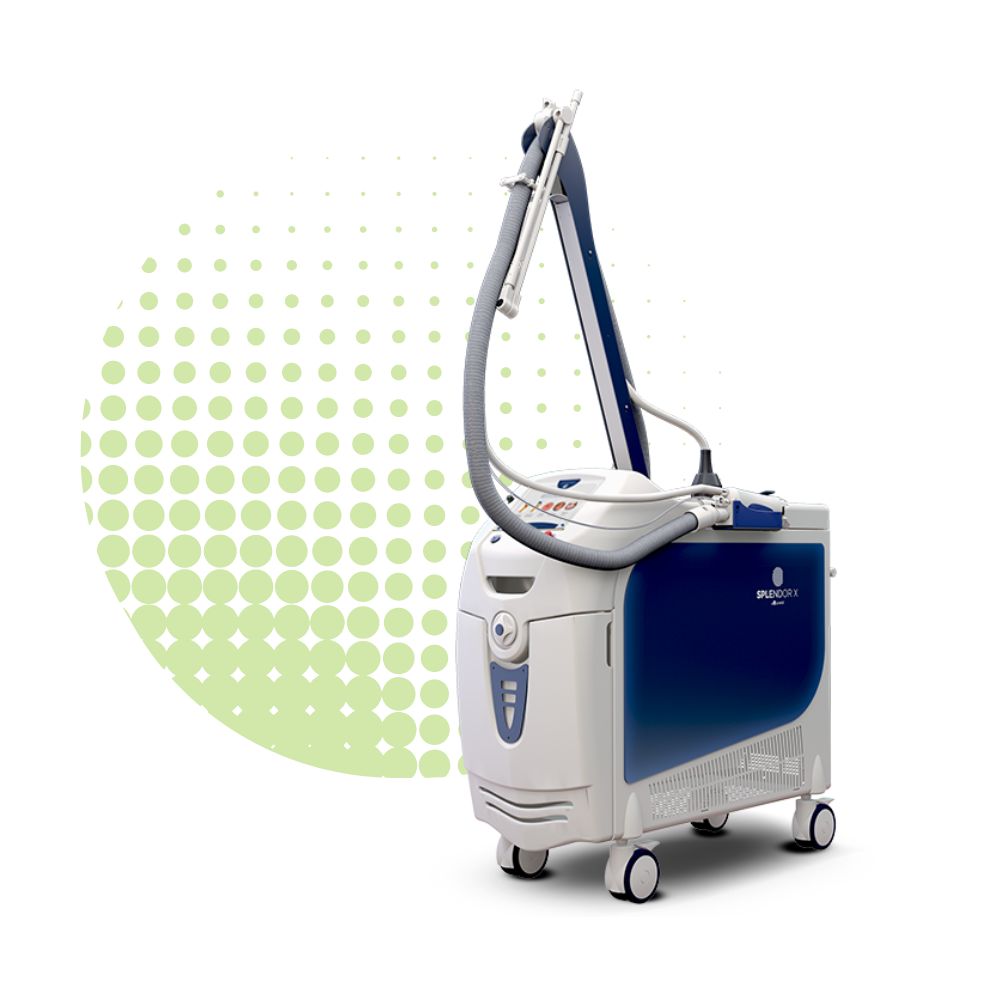
Feel the confidence that comes with splendor x
The Splendor X laser hair removal system by Lumenis is an innovative solution for achieving smooth, hair-free skin. With its unique blend of two wavelengths.
- The system is effective for all skin types, including tanned skin.
- Delivers long-lasting results. Patients can enjoy long-lasting results, with many experiencing permanent hair reduction after just a few treatments.
- The Splendor X also offers faster treatment times and fewer sessions than traditional hair removal methods, making it a convenient and cost-effective option for busy individuals looking to achieve silky smooth skin.
Watch How it Works!
FAQs
1. What is laser hair removal?
Laser hair removal is a procedure to remove unwanted hair from the body by using a laser beam light with different wavelengths against the skin. The limits on strength or power used on a laser is carefully designed by countless studies conducted of the hair follicle to best match the laser light and pulse duration to the follicle size, depth and location in efforts to stop hair from re-growing. Laser hair removal is performed by a certified trained laser specialist or a physician, who places the positioning of the long pulse laser onto the skin. The laser works by ultimately destroying hair follicles that are in their active growth cycle at the time of treatment. A percentage of hair follicles are active at any given time while other hair follicles enter this active phase at different times, therefore, several treatments are needed to destroy all the hair follicles per given area.
A set of at least 6-9 treatments every 4-6 weeks are generally necessary to achieve significant hair removal with any laser system. Factors that determine the length of treatment include area to be treated, the texture of hair, frequency of treatments, history of waxing, tweezing, shaving, and depilatories, etc.
2. Am I a candidate for laser hair removal?
Men and women both qualify for laser hair removal. The process works best on light (pale) skin and dark coarse hair. The closer you are to this combination, the better the results will be. Touch of Class Laser Center’s diode laser works for all skin types (I to IV, even VI) see Question #12 below to determine your skin type. When at Touch of Class Laser Center, we provide an environment in which our priority is client safety, health, and positive results. Laser hair removal targets the melanin (pigment) of hair. With this considered, laser hair removal is ineffective against red, blonde, and gray hairs due to the missing melanin factor within the hair follicle.
3. Is laser hair removal permanent?
The typical mindset is that laser hair removal is permanent, and the Food and Drug Administration approved this procedure calling it permanent reduction. Generally, this means clients shouldn’t think of laser hair removal as a procedure that will rid every single strand of hair from an area. In general, clients are educated on the aging process which may develop new growth requiring touch-up treatments 1-2 times annually after the first set of treatments. At Touch of Class Laser Center, we strive for honesty as our best policy teaching clients to keep in mind that it’s nearly impossible to judge how someone’s body system works, as we are all different in genetic makeup possible lack of results may be due to the person’s potential underlying medical condition, which may cause continuous growth and make it seem like laser isn’t working, Basically, you can’t determine this for yourself unless you try it. Also to be considered, results depend on multiple factors involved, including the technicians experience, type of laser used and how settings are set, etc.
4. How does the Splendor X laser hair removal system work?
The Splendor X laser hair removal system uses a unique blend of two
wavelengths, Alexandrite and Nd:YAG, to target hair follicles and
permanently reduce hair growth. The laser energy is absorbed by the
melanin in the hair follicle, which destroys the follicle and prevents
future hair growth.
5. Is the Splendor X laser hair removal system safe?
Yes, the Splendor X laser hair removal system is safe. It has been FDA cleared for permanent hair reduction and has been shown to be effective on all skin types, including darker skin tones. The system also features a built-in cooling mechanism to minimize discomfort during treatment.
6. Laser Hair Removal: Pre and Post Treatment
BEFORE: Clients are advised to shave the treatment area completely flat and even to their skin 1-2 days before treatment (If clients cannot for any reason, please advise the receptionist that you would like this service done for you during your appointment and we will allocate the proper time necessary to perform this service for you — fees apply — If we are not advised prior to your scheduled appointment and shaving has not taken place even to your skin (no stubble) clients will lose their appointment and will be asked to return another day).
No waxing or removal of any hair root is allowed 4-6 weeks before and throughout the treatment because the hair needs to be fully present to be targeted by the laser. The treatment area should be shaved as closely as possible so that laser does not waste most energy on the part of the hair above the skin’s surface but rather towards the hair follicle and not waste energy. If it is hard to see where you shaved right after, make it a bit easier on your technician not to miss the spots you want treated by shaving 1-2 days before so the outline of where hair is growing is just barely visible.
AFTER: Completed clients are recommended to apply aloe vera to soothe the skin for a few days as needed. Within 2-3 weeks, you should see hair shedding in the areas treated. In the beginning hair looks like it’s growing back, but it is rather coming through the skin to shed. Shedding starts at about 1 week and can last until 4 weeks after treatment or so. Exfoliating and/or scrubbing gently in the shower with a loofa can help speed up the process. After shedding finishes, you might experience little black dots still stuck in the skin. These are called pepper-spots and will shed as well, but may take a bit longer. Exfoliate to help those stubborn hairs as well.
MEANWHILE: Clients should experience a hair-free period for a couple of weeks, until the other dormant hairs begin to grow out. Now, come in for another treatment. This usually happens within 4-6 weeks after treatment. Clients will continue the treatment sets until they reach a significant decrease in return of hairs, or until you have reached you desired reduction.
7. How many treatments are required for optimal results?
Most clients are treated at least 6-9 initial times, spaced 4-6 weeks apart. This is because hair grows in 3 phases and is destroyed in the first anagen active growing phase. Several treatments are needed to effectively kill all hairs in the active growth phase. Approximately 4-6 weeks after every treatment, additional treatment is required to get rid of the hairs that came out of the dormant phase and are now active. After 6-9 treatments or so, clients will see a considerable percentage of hair reduction. Depending upon hair type and genetic factors, some clients may require additional treatments beyond these initial treatments. If for any reason it seems the treatments aren’t working AT ALL after 6-9 treatments, Touch of Class Laser Center advises clients to look into possible underlying reasons.
Usually, treatments are spaced 6-8 weeks apart to start, and gradually move to 8-10 weeks apart after the initial 2-3 treatments. Instead of following an arbitrary schedule, wait until you have experienced shedding of the treated hairs (should complete within 2-3.5 weeks) and you see enough hair come in after the hair-free period to justify the next treatment.
8. Is laser hair removal painful?
Everyone’s pain threshold is different, but generally laser hair removal is LESS painful than waxing, with the revolutionized vacuum-assisted technology clients report it as Virtually Pain Free on a pain scale of 0-5 calling it 0-1 (see our video section for a preview). It resembles a rubber band snapping against the skin for a quick second with each pulse. Most people do not require an anesthetic cream (like EMLA), but for some clients with very sensitive skin/areas such as the face if it makes them more comfortable we will apply the creams.
9. What are the possible risks and side effects of laser hair removal?
The possibility exists that some side effects or complications can occur given various variables, including:
Normal:
- Itching, during treatment
- Redness for up to 3 days
- Swelling (around the mouth) up to 3 days
- Pain, tingling, or feeling of numbness
Rare:
- Crusting/scab formation (on ingrown hairs)
- Bruising
- Purpura (purple coloring of the skin) on tanned areas
- Infection
- Temporary pigment change (hypo-pigmentation or hyper-pigmentation)
Side effects occur infrequently and, as a rule, generally are temporary. If any of the above last for more than 3 days, make sure to contact your technician and/or doctor. The technician needs to know in order to adjust settings on your following treatment.
10. What are the causes of excessive hair growth and how it can affect treatment?
The causes of excessive hair growth pattern are many and varied, including:
- Heredity
- Pregnancy
- Glandular and/or hormonal imbalances (possible PCOS condition for women), including diseases causing these effects
- Insulin resistance issues
- Reactions to certain medications
- Normal aging processes
- Excessive temporary removal methods like waxing, tweezing, creams and depilatories, etc
11. What is the hair growth cycle and how does it work?
There are three phases of the hair growth cycle:
- Anagen (active) is the growing phase or when the hair fiber is produced. During anagen, the hair contains a great quantity of melanin, the pigment which gives your hair its color. This is the phase during which laser hair removal treatment is most effective.
- Catagen (club hair) is the period of controlled regression of the hair follicle. This phase is when the lower part of the hair stops growing, but does not shed, and the follicle is reabsorbed. It will be difficult for permanence to be achieved when the hair is in the catagen growth cycle.
- Telogen (tired) is the last of the hair growth cycle. In this resting phase, the old hair falls out in preparation for the development of a new anagen hair. Permanence cannot be achieved when the hair are in the telogen growth cycle.
12. How do I determine my skin type?
TYPE I:
Highly sensitive, always burns, never tans.
Example: Albino
TYPE II:
Very sun sensitive, burns easily, and tans minimally.
Example: Fair-skinned, fair-haired Caucasians
TYPE III:
Sun sensitive skin, sometimes burns, slowly tans to light brown.
Example: Darker Caucasians, European mix
TYPE IV:
Minimally sun sensitive, burns minimally, always tans to moderate brown.
Example: Mediterranean, European, Asian, Hispanic, American Indian
TYPE V:
Sun-insensitive skin, rarely burns, tans well.
Example: Hispanics, Afro-American, Middle Eastern
TYPE VI:
Sun-insensitive, never burns, deeply pigmented.
Example: Afro-American, African, Middle Eastern


